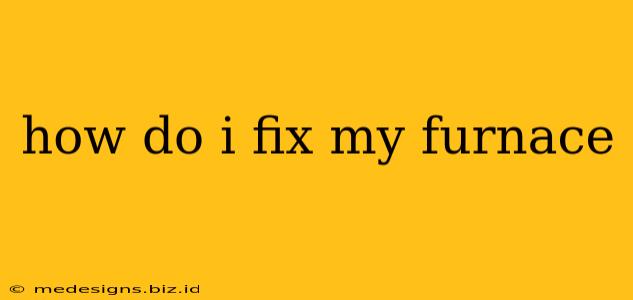A malfunctioning furnace can turn a cozy home into an icy wasteland. Before you call an expensive HVAC technician, let's troubleshoot the problem. This guide will walk you through common furnace issues and offer DIY solutions where possible. Remember: safety is paramount. If you're uncomfortable working with gas appliances or electricity, call a professional immediately.
Common Furnace Problems and Solutions
Here are some of the most frequent furnace problems homeowners encounter, along with potential fixes:
1. Furnace Won't Turn On
- Check the Circuit Breaker: This is the most common culprit. Locate your electrical panel and check for a tripped breaker related to your furnace. Reset it by flipping the switch off and then back on.
- Inspect the Thermostat: Ensure the thermostat is set to "heat" and the temperature is set higher than the current room temperature. Check the batteries if it's a battery-operated model. Also, make sure the thermostat itself is properly wired and functioning correctly. A faulty thermostat is a frequent cause of furnace malfunctions.
- Pilot Light (for older furnaces): If your furnace uses a pilot light, verify it's lit. If not, consult your furnace's manual for re-lighting instructions. A consistently extinguishing pilot light could indicate a gas supply issue or a problem with the thermocouple (a safety device).
- Gas Supply (for gas furnaces): Check the gas valve to ensure it's open. Listen for the sound of gas flowing. If you suspect a gas leak, immediately evacuate your home and call your gas company and a qualified HVAC technician. Never attempt to repair a gas leak yourself.
2. Furnace is Blowing Cold Air
- Check the Thermostat: Double-check the settings. Make sure the system is set to "heat" and the temperature is correctly programmed.
- Air Filter: A clogged air filter restricts airflow and prevents the furnace from heating properly. Replace the filter with a new one. This is often the simplest and most effective solution.
- Frozen Condensation Line (for heat pumps): If your furnace is a heat pump, check the condensation line for ice buildup. This can restrict airflow and prevent the unit from operating efficiently. Thaw the line carefully, but again, call a professional if unsure.
- Low Refrigerant (heat pumps): Low refrigerant levels in a heat pump can cause it to blow cold air. This requires professional service.
3. Furnace is Making Strange Noises
- Loud Bangs or Pops: These could signal problems with the heat exchanger, which is a serious safety concern. Turn off the furnace immediately and call a professional.
- Clicking or Humming: This can indicate electrical problems or issues with the blower motor. If the sounds persist, call a technician.
- Screeching or Grinding: These usually point towards a worn-out blower motor or other moving parts requiring lubrication or replacement. Professional repair may be needed.
4. Furnace is Cycling On and Off Too Frequently
- Check the Air Filter: A clogged filter restricts airflow, causing the furnace to work harder and cycle more often. Replace the filter as a first step.
- Low Refrigerant: In heat pumps, low refrigerant leads to short cycling. A professional needs to check the refrigerant levels.
- Dirty Burner: A dirty burner can cause inefficient combustion and frequent cycling. Cleaning the burner might be a DIY project depending on your furnace model. Consult your manual.
When to Call a Professional
While some simple issues can be fixed at home, certain furnace problems require the expertise of a qualified HVAC technician. Call a professional immediately if:
- You detect a gas leak.
- The furnace is producing unusual noises like loud bangs or pops.
- The pilot light won't stay lit (after attempting to relight it according to your manual).
- The furnace is not heating adequately despite troubleshooting.
- You are uncomfortable performing any of the maintenance tasks described above.
By following these troubleshooting steps, you can often resolve minor furnace problems yourself, saving time and money. However, remember that safety is always the top priority. When in doubt, call a qualified HVAC professional.
